What to do if leaves turn black on anthurium?
An original gift for any occasion is a flower "man's happiness" or anthurium... Its interesting bright shade and peculiar structure make you keep your eyes on it, enjoying its wondrous beauty. But in some situations, the plant has a blackening of the foliage. In order to take action, one should first determine the causes of the problem and then act on the flower.
Content:
- Features of the structure of anthurium
- Leaves turn black - the reason: improper care
- How to properly care for a plant
- Leaves turn black - causes: diseases
- How to cure anthurium?
- Leaves turn black - the reason: pests
- What to do how to get rid of them
Features of the structure of anthurium
Anthurium is a plant of a specific nature. He is quite demanding in care and does not tolerate indulgences in the form of a lack of watering or feeding. Therefore, in order to grow a real handsome man, you will have to make some efforts. In the wild, the bush is found in the forests and fields of North America, Mexico, Brazil, Paraguay and the Antilles. Its variety in recalculation captures more than 900 different shades and shapes.
A distinctive feature of the uniqueness of the shrub is its appearance - bright color and non-standard foliage structure. In wildlife, anthurium can grow up to 1 meter in height, and in decorative conditions it reaches a maximum of 60 cm.Its foliage can boast of a different shape.
The sheets can be oval, elongated, heart-shaped, or simply rounded.
In terms of external parameters, the foliage is glossy, fleshy, dense in structure. The leaf blades are leathery, rich green. Some varieties have excellent color veins that are located throughout the surface of the leaf. They can be silvery or yellowish. Rhizomes do not go deep into dense masses of earth. Rhizomes are placed on the surface. Therefore, when planting for a flower, a not deep, but wide flowerpot is selected.
Anthurium blooms can occur almost all year round. But this factor depends on the growing conditions. The flower consists of 2 components - a cob towering over the veil. On the cob, the inflorescences have a square shape and are quite densely located, tightly adjacent to each other. The bedspread is located around a beautiful cob, in the shape of a heart. This part of the flower in wildlife has not only a red hue, but also other tones, such as black, pink or purple, as well as blue, green, bright orange and even yellow.
Leaves turn black - the reason: improper care
Experienced gardeners don't count anthurium a capricious flower. This is due to the fact that a person who has been growing an exotic bush for a long time fulfills all the requirements of a flower, regardless of the situations that have manifested. But even such people have situations when the flower begins to become covered with spots, turns black, leaves fall off and the entire original appearance is lost.
The general malaise of the bush can be caused by a number of specific reasons:
- Wrong lighting in summer or winter time.
- Changes to the fertilization schedule.
- Increased room temperature resulting in excessive dryness of the air.
- Finding in the substrate in large volumes of calcium salts.
- Drafts.
- Direct sunlight.
- Errors in the implementation of watering.
Anthurium suffers from these reasons most often. Failure to meet certain conditions causes an instant response from the bush and a long recovery process. Somewhat less often, the shrub suffers from sudden changes in temperature. Such a condition is easier for the exotic than the bright lighting on the southern windowsill. The flower also reacts calmly when growing a shrub at a low temperature. If you make a sharp decrease in the degrees that are comfortable for staying, then the flower can respond to the development of the disease. Otherwise, with a gradual decrease in degrees, the shrub will tolerate the introduced conditions favorably.
In order to prevent the negative state of anthurium, it is recommended, first of all, to fully follow the rules for leaving the bush.
With the development of blackness, you should not immediately throw away a valuable specimen of an exotic bush. It is worth looking inside the anthurium and trying to fix the problem from the inside by adjusting the conditions of detention.
In addition to common reasons, the leaves of anthurium can turn black due to the natural aging of the leaf blades. If this is observed, then you should not sound the alarm and take great care of the pet. Overprotectiveness at some point can do more harm than neglect. Therefore, initially, in order to find the reasons, it is recommended to make sure that it is time for the plant to throw off some of the leaf plates.
How to properly care for a plant?
In order for the shrub to please its owners all year round with active and bright flowering, for this it is necessary to constantly fulfill certain conditions for growing:
- The choice of placement - high-quality lighting has a beneficial effect on the entire flower as a whole. When a flowerpot with a flower is placed in direct sunlight, the leaf plates begin to immediately become covered with brown-black spots of burns. Therefore, it is recommended to expose anthurium to the southeastern or western sides so that the bush receives a sufficient amount of sunlight, but at the same time it has a darkening at noon with baking rays. If the bush does not receive enough rays of the luminary, then this will also negatively affect the general condition, which will lead to the complete death of the bush.
- Humidity of the environment - anthurium quite problematically tolerates increased dryness of the air; for a comfortable flower keeping, it is necessary to reproduce the tropical humidity in the room. Therefore, for a comfortable stay, it is recommended to spray the leaf plates of the bush every day, while it is imperative to control that drops of moisture do not fall on the surface of the inflorescences
- High-quality watering - on hot summer days, it is recommended to introduce nutrient moisture into the soil no more than 2-3 times a week. Although the bush loves moisture around it, excessive exposure to moisture on root system leads to decay of rhizomes and complete death of the bush. Therefore, it is recommended to add water only if necessary, when the topsoil dries out 2-3 cm deep. In winter, irrigation should be reduced to 1 time per week. In addition, experts recommend periodically installing a flowerpot with a flower in a basin filled with water. The procedure is carried out for several minutes, and then the flowerpot is removed, while the excess water should be allowed to drain completely. Such watering is the most favorable for exotic plants.
- Selected soil, taking into account the needs of anthurium - favorable growth is provided by a mixture of oak bark, river sand and crushed peat. To make the plant feel comfortable, it is recommended to plant it in a plastic pot. In order not to provoke blackening of the leaf plates, in addition to certain conditions, it is necessary to fulfill the requirements for watering the soil. For that, it is necessary to take settled water, soft in structure. Hard water negatively affects the soil structure, additionally saturating it with a significant amount of calcium. At the same time, there are fewer other nutrients in the soil, designed for the qualitative growth of an exotic pet. Before watering, be sure to check the temperature of the irrigation water. With the introduction of cold water, anthurium also suffers, as with the introduction of nutrient moisture of a hard nature. The shrub develops well when watering is carried out with water, room temperature not lower than +18 C.
- In the winter months, it is recommended to move shrubs away from heaters or heat-breathing batteries. If there are no conditions for transferring the bush to another room, then it is recommended to install a tray with water next to the flowerpot so that the evaporating moisture settles on the leaves, thereby increasing the humidity.
Improper watering can lead to the development of rotting or fungal disease. Therefore, it is worth controlling the moisture supplied to the pot so as not to provoke moisture stagnation. After adding the nutrient moisture, it is recommended to wait until the excess moisture drains off and pour out the excess water.
If it is noticed that a large number of black spots appear on the surface of the leaf, then it is necessary to check the root system.
Perhaps the rhizomes are suffocating from lack of air. To improve the condition, the surface should be loosened. To identify the reasons for the development of an unfavorable condition, it is worth observing the plant constantly. The identified problem can be neutralized at the first stages of development, than then to throw out the completely dead bush.
Leaves turn black - causes: diseases
Like all other plants, anthurium tends to be subject to various diseases. Anthracnose is most often found in shrubs. The formation of the disease occurs for several reasons:
- Attachment of infectious diseases.
- Incorrect observance of the rules for carrying out agricultural techniques.
- Parasitic individuals introduced to the bush with a new specimen purchased.
If a shrub was purchased and displayed next to a home collection, without observing the rules of quarantine and the required hygiene, then not only pests, but also infections of various types can easily migrate to other shrubs. At the same time, pathogenic bacteria or viruses are easily acquired on plants weakened after the winter cold.
In most cases, anthurium is exposed to the following water diseases:
- Fusarium wilting - affects not only all leaves and stems, but also negatively affects the root system. The first sign is not blackening of the leaf plates, but a sharp unreasonable wilting of the plant, the peduncles unnaturally begin to bend, changing their normal location.
- Anthracnose - otherwise referred to as powdery mildew. The disease is caused by a specific fungus. The defeat of the bush leads to the fact that not only green leaves dry out, but also the stem and even the root system. The most favorable environment for the development of the disease is excessive moisture of the soil substrate.
- Septoria is a fungal disease that actively develops in a warm and humid environment. It appears as yellow spots, with a brown rim around the edges. The leaf dries quickly and the rapidly growing spores easily infect the neighboring plant.
- Rust - when infected, orange growths appear on the anthurium. This is due to the fact that the air becomes rather dry and rough.
In order to save the shrub in time, it is recommended to apply rescue efforts already at the initial stages of development. A long wait will lead to the complete death of an exotic pet.
How to cure anthurium?
To cure a plant from any disease, it is recommended to properly care for a capricious plant. To fix the problem, it is recommended to immediately contact the effect chemical fungicides.
Features of plant treatment:
- In such a situation, with a fungal disease or infection with bacteria or viruses, the chances of self-salvation are extremely small. When infected with viral diseases or various infections, the likelihood of cure is extremely small. All sheet plates must be urgently removed and incinerated.
- With the development of septoria, the leaves should be sprayed from a spray bottle with a chemical fungicide, which contains a large amount of copper. In the event of rust development, the bush should be additionally sprayed, increasing the air humidity around, but the affected greens should be completely removed and burned.
- To neutralize anthracnose, it is necessary to reduce watering and irrigate anthurium with preparations with the addition of copper fungicides. Additionally, the soil substrate should be treated with the chemical Abiga-Peak. If there is no way to heal the plant, it has to be completely burned so that the disease does not spread to other plants.
- To eliminate fusarium wilting, you will have to treat the plant with copper insecticides and irrigate the soil substrate with glyocladin. It is best to get the shrub out of the ground, remove all the soil, keep the plant for a short period in a weak solution of potassium permanganate and plant it in fresh soil. The latter must first be disinfected.
Leaves turn black - the reason: pests
Pests that like to settle on anthurium include aphids, root nematodes, spider mites, scale insects or thrips. All these parasites feed on sap from the plant, located on the lower cavity of the leaf plates, as well as in the connectors of the leaf and stem.
A rather dangerous enemy is the spider mite.
To neutralize it from the plant, you have to fight. The first signs of a mite are a cobweb formed in the branching of the leaf plate and the stem. The cobweb gradually grows, occupying the entire area, and absorbs the plant, causing it to dry out and die. Not a single flower is immune from the invasion of these parasites. They can colonize by being transported with the wind, as well as if an infected plant has been acquired.
What to do, how to get rid of them?
It is quite problematic to fight with the scabbard. This is due to the fact that small insects are almost invisible at first. Thrips manifest themselves when small black dots are found on the leaf plate. With an invasion of a spider mite, it is necessary to wipe the leaves, remove the cobweb that forms, eliminate the parasites found, manually collecting pests. In this case, you should additionally wipe the surface on which the flowerpot is located, and the flowerpot itself. It is imperative to rub the foliage thoroughly with a soapy ash solution.
To prevent parasitic insects from infecting the plant, it is periodically recommended to irrigate it with pest-fighting chemicals.
In addition, it is imperative to monitor the condition of the green pet. If a small number of parasitic individuals are seen, then they should not be left for further reproduction and increase in numbers. It should be collected by hand as it is identified, as well as folk methods should be applied. If the number of pests is large enough, you will have to resort to chemical insecticides.
More information can be found in the video:
The main thing in the fight against parasites is to determine the presence of pests in the early stages of development.Otherwise, insects tend to multiply quickly, completely filling the entire plant, sucking nutrient moisture and juice from leaves and stems, thereby destroying exotic shrubs.
Thus, so that anthurium is not exposed to various diseases and the invasion of pests, its condition should be constantly monitored. It is necessary to take care of the flower and provide high-quality care for the capricious plant. Otherwise, there is a possibility of losing the entire shrub.



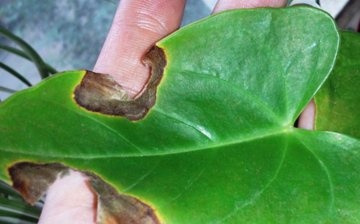
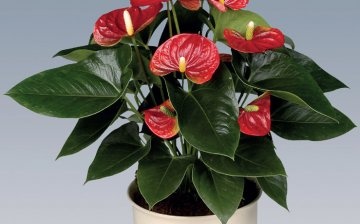
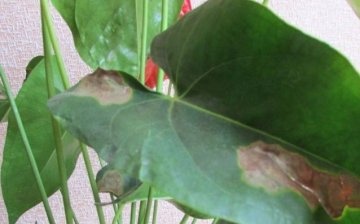
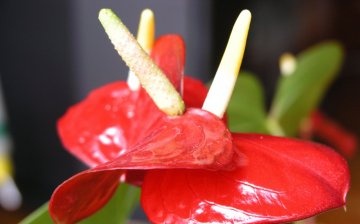
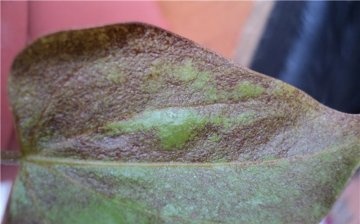









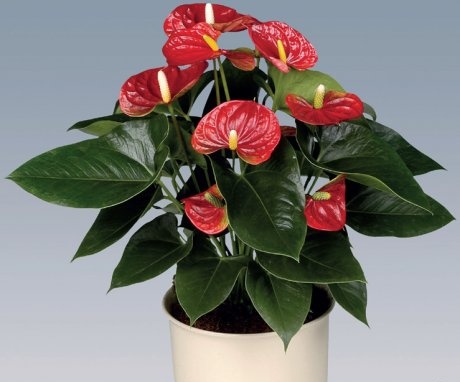
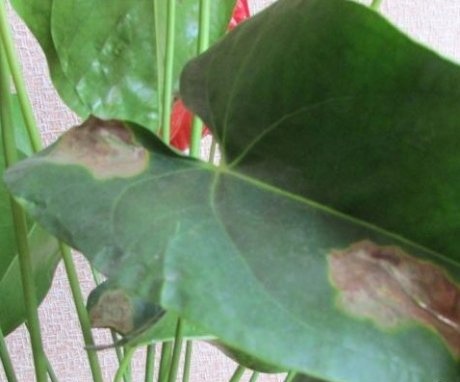

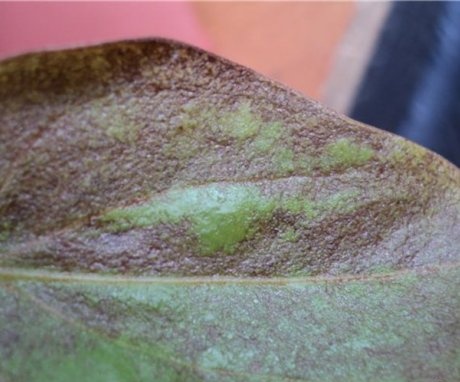
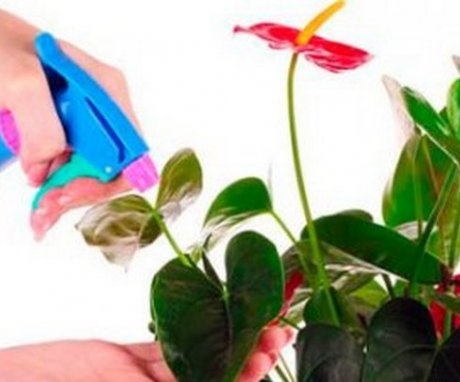
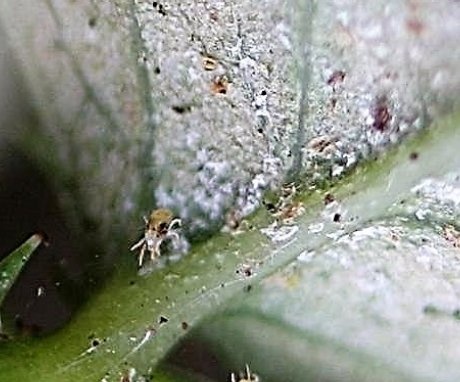
Anthurium is really a very moody flower, but it grows with me. I fertilize twice a year, and it is also important to observe moderate moisture in the soil and air too. I have not noticed pests yet, there is a high probability of bringing them in with new flowers or soil.